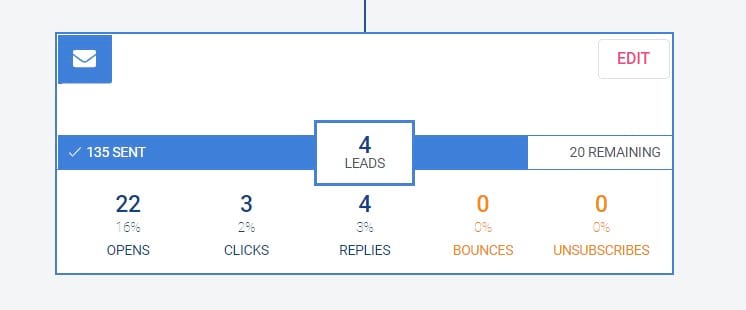Great! That’s another email campaign sent but just how successful was it? Did it reach your target audience? How did it perform? What’s the ROI? If you answered “I don’t know” to most or all of these questions, how do you know if your email was effective or not?
We get it. You’re bombarded with statistics on how important email campaigns are to a business, and the figures are big. When you have email marketing generating an ROI of 4200% and 59% of B2B marketers preferring email for lead generation, knowing how your email campaigns are performing is crucial.
There is an abundance of tools, metrics, automated systems and lead generation solutions available to measure email effectiveness. But do you know your click rate vs open rate? Do you understand your click-through-rate vs conversion rate? Then there’s the all-important bounce rate, engagement rate and overall ROI. It’s a minefield.
Need help running an email campaign that actually gets results? Reach out to us and we can help you start driving new leads with targeted campaigns.
Why Measure the Effectiveness of Email Campaigns?
Let’s start with a question. In respect of online purchases by internet users, what has more impact, social media or email promotions? In today’s digital era, you’d opt for social media. But no, it’s email promotions. 60% of internet users will purchase as a direct result of an email compared to 20% of users who follow brands on social media looking for a deal. But if there wasn’t a measurement of emails, you wouldn’t have these statistics.
How you measure your email marketing success is a key to business growth. If you don’t track and evaluate the performance of your email marketing, how do you get to know your audience, or discover what works and what doesn’t? Included in the email planning stage should be the metrics you are going to use to measure and analyze its performance.
Using key performance indicators (KPIs) to measure the metrics you have chosen will draw out the best insights from your email marketing.
What are Email Marketing KPIs?
So, how do you improve your email marketing conversion rate? By using Key Performance Indicators which represent the important metrics for measuring your email marketing performance, conversion rates will increase. They are measurable, quantifiable metrics that can be used to assess how your email campaign is performing according to your goals.
The KPIs for the email you set should also be measured against your planned goals and strategies. By measuring your email marketing campaigns against your KPIs, as well as your goals, measuring performance will be more effective.
Remember that your goals should be SMART (Specific, Measurable, Attainable, Relevant and Time-bound). KPI metrics track the performance of a key business process, which is why they are linked with your KPIs. Every business’s KPIs are different to the next because each business has different objectives and core goals.
Important Email Marketing Measuring Metrics

What needs to be considered before setting email marketing KPIs? Before setting a metric as a KPI, it’s important to understand what a metric measures.
- Delivery rate – this metric tells you how many emails landed in subscribers’ inboxes. The aim is a 100% delivery rate, i.e. all emails landed in an inbox and didn’t bounce. However, a 95% success rate is considered a good delivery rate.
- Open rate – this metric is the basis of email marketing KPIs and shows how many subscribers opened your email. The open rate provides a good indication of how well your email subject line was received. Research shows that subject lines that include the subscriber’s first name are 26% more likely to be opened. Here are great email subject line tips from Bant.io that will result in increased open rates. So, on average, email campaigns generate an open rate of around 24%. If you achieve an open rate higher than this, analyze what has worked and apply this to your next campaign.
- Click-Through-Rate (CTR) – this is a commonly-used metric that measures how many subscribers clicked on the links included in your email. Examples of links include an offer, a free e-book or a specific call-to-action. These can be inserted in several places throughout the email that are appropriate. Ensure the call-to-action button can be clearly seen and stands out. This metric is also helpful in A/B testing results and determining ways to increase clicks on links in emails. CTRs traditionally are significantly lower than open rates. The average click-through-rate is around 4-5%. It provides you with an insight into how many of your subscribers are engaging with your email content and want to know more about your business or offer.
- Click-To-Open Rate (CTOR) – although this metric is similar to the click-through-rate, it’s different in that it is based on the subscribers that opened your email, instead of your entire subscriber list. So, it is the number of subscribers that opened your email and went on to click on the links. In general, CTORs average from 20-30%. In comparison to open rates, click-through-rates and click-to-open rates give you a much clearer picture of how effective the email content has been.
- Conversion rate – so, you have your click-through-rate and you have your click-to-open rate. The next important metric to measure is how many subscribers who clicked on your link, i.e. a special offer, went on to complete a specific action? The conversion rate will indicate your return on investment (ROI), thereby determining whether your email campaign achieved your goals. By integrating your email platform with your website analytics, you will be able to identify which email campaign generated the click to conversion.
- Email bounce rate – this metric tells you the percentage of emails that did not reach the subscriber’s inbox. There are two types of bounces, hard and soft. Hard bounces indicate closed or invalid email addresses, or it didn’t exist at all. Therefore, any email will never reach these subscribers. These bounces must be removed from your subscriber lists as soon as possible, mainly because internet service providers (ISPs) use bounce rates as one of their criteria in assessing whether it is spam email or not. Soft bounces usually mean there’s a temporary issue with an email address that is valid, such as the subscriber’s inbox is full or there’s a problem with their server. It’s always worth re-sending email messages to soft bounces. A high bounce rate indicates that your subscriber list has too many old, fake or incorrect email addresses and this should be resolved before using the list again. A great way to reduce bounce rates is through a double opt-in. It asks subscribers to verify their email address and confirm they still want to receive emails from you. Email validation, the process of cleaning up email subscriber lists, is a key process in discovering the percentage of recipients’ email addresses that are still accurate and valid. As well as this, other ways to reduce bounce rates include keeping paragraphs short and concise, improve content readability, avoid broken links, use a great, responsive design and ensure your landing page loads quickly.
- Unsubscribe rate – this metric is the number of email recipients that have unsubscribed from your email list after opening an email. The unsubscribes rate doesn’t give you a clear indication of how accurate your email list is. Most recipients, if they’ve had enough of your emails simply won’t open them, or just delete them entirely. Generally, they don’t use the unsubscribe link. To measure the effectiveness of your email subscriber list, track engagement using click-through-rates, click-to-open rates and conversions. An unsubscribe rate that is less than 0.5% is generally considered a good percentage for email campaigns. So, how can you increase your email list growth rate? Opt-ins and email validation methods will help to reduce unsubscribe rates and improve your subscriber list.
Which Email Marketing Metrics Should You Track?

Email metrics are critical to measuring the success of your email campaigns. If you don’t know who is opening your emails, who’s clicking on your links and making purchases, there’s no point in sending emails. But which email metrics should be tracked to learn the best insights into your email marketing performance?
- Open rates – most automated email service providers, such as Mailchimp or Constant Contact, will track your email campaign open rates. If your open rates are low, either your email list is not up-to-date, your subject line is not engaging the recipient, or you haven’t optimized your emails for mobile.
- Click-Through-Rates (CTRs) – this metric will indicate how successful your content and links are, and the level of engagement. If your CTR is low, consider split testing your email campaigns. Use A/B testing on email subject lines, mobile layouts, content length and format, call-to-action buttons and the design.
- Conversion rates – the conversion rate tells you how many recipients not only clicked on the links but went on to complete an action, such as making a purchase, signing up for a course or downloading an e-book. With 60% of marketers saying they use this metric to monitor their email campaign’s progress, it is probably the most important to track. But what is a good email marketing conversion rate? The average conversion rate of emails in 2020, according to Barilliance.com, was 15.11%.
- Return on Investment (ROI) – calculating your email campaign’s ROI is crucial to understand how successful or not. What is the average ROI for email marketing? Well, an eMarketer study showed that email marketing had a median ROI of 122%; that’s as much as four times higher than any other form of marketing. Clearly, email marketing is the most used tool for businesses today in generating revenue.
How to Optimize Your Email Campaigns

So, you’ve decided which metrics you are going to use to track and measure your email campaigns. You’ve set your KPIs and linked them to your goals. But what can you do to optimize your emails to generate the maximum ROI?
- Great subject lines – the first content your recipient will see is the subject line. Keep it simple, concise and preferably no more than five to six words. Ask a question or make it catchy. Alternatively, personalize the subject line to the subscriber by using their first name.
- Optimize for mobile – 50% of emails are opened on a mobile device. Seems obvious but you’d be surprised at the number of email campaigns that haven’t considered how it will look on a mobile device. When 70% of emails that aren’t displayed correctly on a mobile device being deleted, optimizing for mobile is crucial. Make sure all links open correctly. If you’re using images, are they opening on a mobile device? How does your design look on a mobile? Is your landing page optimized for mobile? If you’ve got a cookies notice, can the email recipient see it to accept cookies?
- Clear call-to-action buttons – so, you’ve hooked your recipient. They want to know more about your business and offer but they can’t see the call-to-action button clearly. Hubspot studies found that a personalized CTA will increase email conversions by 202%. Make sure CTA buttons stand out throughout your email and are consistent.
- An effective landing page – great! You’ve optimized your email and your recipients are clicking on the CTAs but they’re not converting… why? Well, how’s your landing page working? It is either not opening at all, it’s not loading quickly enough or it’s not optimized for mobile.
- An accurate, up-to-date subscriber list – no matter how great your email content is, if it’s not reaching the right recipients’ inbox, it’s going to fail. An effective B2B sales process will identify leads to be converted into customers by the sales team. Just buying a subscriber list is not enough. There are many lead generation platforms in the market, such as bant.io, that salespeople are able to use to identify and engage with target customers using cross-channel lead generation strategies. Email campaigns can be monitored through bant.io’s platform directly from the dashboard, allowing the adjustment of the campaign’s parameters in real-time.
Creating a Measurement Plan
A measurement plan clearly identifies the objectives and goals of your email marketing plans, details the metrics to be used to measure and the KPIs that have been set out. Every step of your measurement plan has to be accountable, specific and data-driven.
- Define the email campaign objectives – what is the purpose of the email campaign? How are you creating customer value? What are your business goals? Whether it’s to increase sales, build customer loyalty, gain market share or improve brand awareness, establish your objectives.
- Establish your KPI metrics – a list of objectives is one thing but your KPIs are the measurable, quantifiable metrics by which you assess the performance of your email campaign. For example, if your objective is to increase sales, your KPIs define how that will be achieved, such as reducing abandoned carts or increasing cross-selling.
- Measure your campaign’s performance – without measurement, there’s no way of telling if your email was successful or not. Define the metrics you will be using to measure the email’s performance against your objectives and key performance indicators. For example, with the objective to increase sales and a KPI to improve cross-selling, it can be measured by the average number of items being purchased per transaction.
- Analyze and implement – you should now have a set of objectives, your KPI metrics and the data from measuring your email campaign. Once this information is pulled together, analyze the results to gather valuable insights to understand what was successful, what didn’t work and what you are going to implement in the next email campaign.
What to Test to Improve Your Email Marketing Campaigns?

As many as 39% of brands don’t test their emails and wonder why it didn’t generate the response they were anticipating. It is always recommended you A/B test your email campaign to see where you can improve open rates, click-through-rates and conversions.
A/B testing is sending two or three variations of your email content, adjusting different areas such as the subject line, length of content or call-to-action buttons, to a small subset of subscribers. By monitoring metrics like open rates and click-through-rates, you will be able to assess which version generated the best response. The winning version can then be sent to the remaining subscribers.
When conducting A/B testing, the key areas to test are:
- Subject lines – the good, engaging subject line is a key element to email performance. When it reaches a subscriber’s inbox, it’s the first thing that’s viewed. With many more people viewing their emails on mobile devices, make sure it is optimized for mobile. A recent study from Return Path concluded that the optimum length for a subject line is 61-70 characters. Consider personalizing the subject line and the order of the words.
- Content – vary the length, tone and style of the email content. Remember that the go-to place to view emails is the mobile so keep the content clear and concise for easy reading.
- Images and visuals – research has demonstrated that the brain processes visuals 60,000 times faster than text. Visuals and images get your message across to the recipient far more quickly than a ream of text. However, don’t overload your email with images or it could be distracting.
- Call-to-action buttons – reading an email is a process from top to bottom and guides the recipient along the way. Ensure the call-to-action buttons are prominent so the reader knows where to go to action their interest.
With email marketing being the prominent tool for businesses in promoting their products and services, is it still effective? According to statistics, yes, it is but getting it right is crucial to avoid wasting time and money. Measuring the response and effectiveness of your email marketing efforts is a key element to assessing email performance and ROI.
The better the planning, measurement and execution, the more valuable the insights that can be built upon to achieve your email marketing strategy and business goals. Adopt the Triple-A approach to email measurement – Analyze, Assess and Adjust.
Measuring the effectiveness of your email campaigns doesn’t need to be complex, but it does need to be a crucial element of your online marketing strategies.

